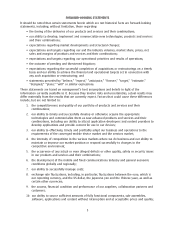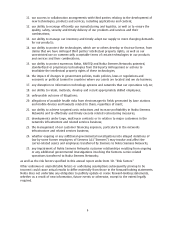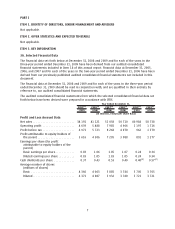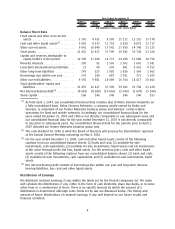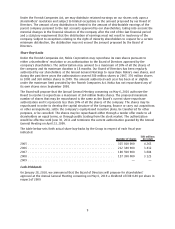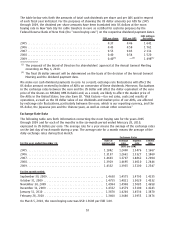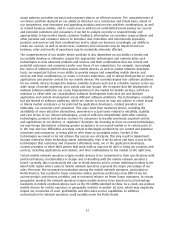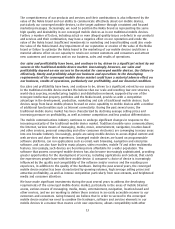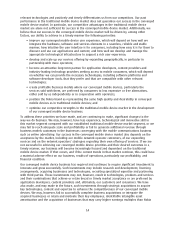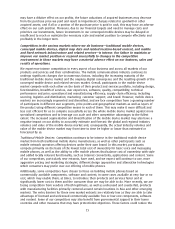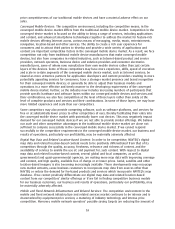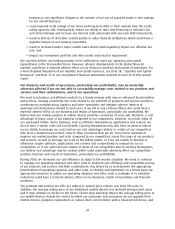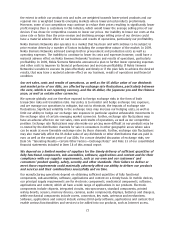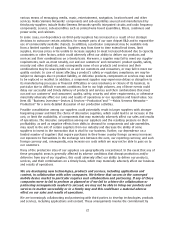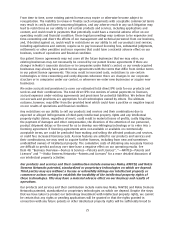Nokia 2009 Annual Report Download - page 17
Download and view the complete annual report
Please find page 17 of the 2009 Nokia annual report below. You can navigate through the pages in the report by either clicking on the pages listed below, or by using the keyword search tool below to find specific information within the annual report.may have a dilutive effect on our profits; the future valuations of acquired businesses may decrease
from the purchase price we paid and result in impairment charges related to goodwill or other
acquired assets; and if all or a portion of the purchase price is paid in cash, this may have an adverse
effect on our cash position. Moreover, due to our financial targets and need to manage costs and
prioritize our investments, future investments in our converged mobile devices may be delayed or
insufficient to reach or maintain the necessary scale and market position to compete effectively and
profitably in the longer term.
Competition in the various markets where we do business—traditional mobile devices,
converged mobile devices, digital map data and related locationbased content, and mobile
and fixed network infrastructure and related services—is intense. Our failure to maintain or
improve our market position or respond successfully to changes in the competitive
environment in those markets may have a material adverse effect on our business, sales and
results of operations.
We experience intense competition in every aspect of our business and across all markets of our
products and services and their combinations. The mobile communications industry continues to
undergo significant changes due to numerous factors, including the increasing maturity of the
traditional mobile device market and the ongoing digital convergence and the resulting growth of the
converged mobile device and related services market. Overall, participants in the mobile device
market compete with each other on the basis of their product and services portfolio, including design,
functionalities, breadth of services, user experience, software, quality, compatibility, technical
performance and price; operational and manufacturing efficiency; supply chain efficiency, including
sourcing, logistics and distribution; marketing; customer support; and brand. However, mobile device
markets are increasingly segmented and diversified, and we face competition from a growing number
of participants in different user segments, price points and geographical markets as well as layers of
the product using different competitive means in each of them. This may make it more difficult and
less cost efficient for us to compete successfully across the whole mobile device market against more
specialized competitors and to leverage our scale and other competitive advantages to the fullest
extent. The increased segmentation and diversification of the mobile device market may also have a
negative impact on our ability to accurately estimate and forecast the global and regional industry
volumes and value of the mobile device market and, consequently, the actual industry volumes and
value of the mobile device market may from time to time be higher or lower than estimated or
forecasted by us.
Traditional Mobile Devices:
Competition continues to be intense in the traditional mobile device
market from both traditional mobile device manufactures, as well as other participants such as
mobile network operators offering devices under their own brand. In this market, participants
compete primarily on the basis of the lowest total cost of ownership for basic voice and messaging
mobile phones, as well as the ability to offer mobile phones that balance cost of ownership with style
and added locally relevant functionality, such as Internet connectivity, applications and content. Some
of our competitors, particularly new entrants, have used, and we expect will continue to use, more
aggressive pricing and marketing strategies, different design approaches and alternative technologies
which consumers may prefer over our offering of mobile phones.
Additionally, some competitors have chosen to focus on building mobile phones based on
commercially available components, software and content, in some cases available at very low or no
cost, which may enable them, at times, to introduce their products and services faster and at
significantly lower cost to them and the consumer than we may be able to do. More recently, we are
facing competition from vendors of both legitimate, as well as unlicensed and counterfeit, products
with manufacturing facilities primarily centered around certain locations in Asia and other emerging
markets. The entry barriers for these new market entrants are relatively low as they are able to take
advantage of licensed and unlicensed commercially available free or low cost components, software
and content. Some of our competitors may also benefit from governmental support in their home
countries and other measures that may have protectionist objectives. These factors could reduce the
15


